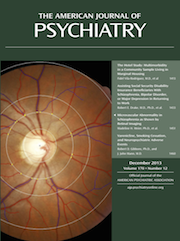Paralimbic Cortical Thickness in First-Episode Depression: Evidence for Trait-Related Differences in Mood Regulation
Abstract
Objective
Impaired mood regulation is a key deficit of major depressive disorder that is primarily mediated by an interaction between the paralimbic cortex (i.e., orbitofrontal, cingulate, insular, parahippocampal, and temporopolar cortices) and limbic regions. The authors investigated whether depressed patients and healthy comparison subjects have differences in cortical thickness in the paralimbic cortex and whether potential differences are evident only during a depressive state or are trait related.
Method
Forty patients with a first episode of major depressive disorder participated: 20 medication-naive currently depressed patients and 20 medication-free recovered patients. The patients and 31 matched healthy comparison subjects underwent structural magnetic resonance imaging. Group differences in mean cortical thickness of the paralimbic cortex were measured by using FreeSurfer software, with adjustment for age, sex, and intracranial volume, and subgroup analyses were performed to assess state and trait effects.
Results
The medial orbitofrontal cortex was thinner in the depressed patients than in the comparison subjects. Greater thickness was present in the temporal pole and the caudal anterior and posterior cingulate cortex. All changes were trait related.
Conclusions
The data provide evidence that even early in the course of depression brain regions involved in mood regulation show trait-related differences in cortical thickness.



